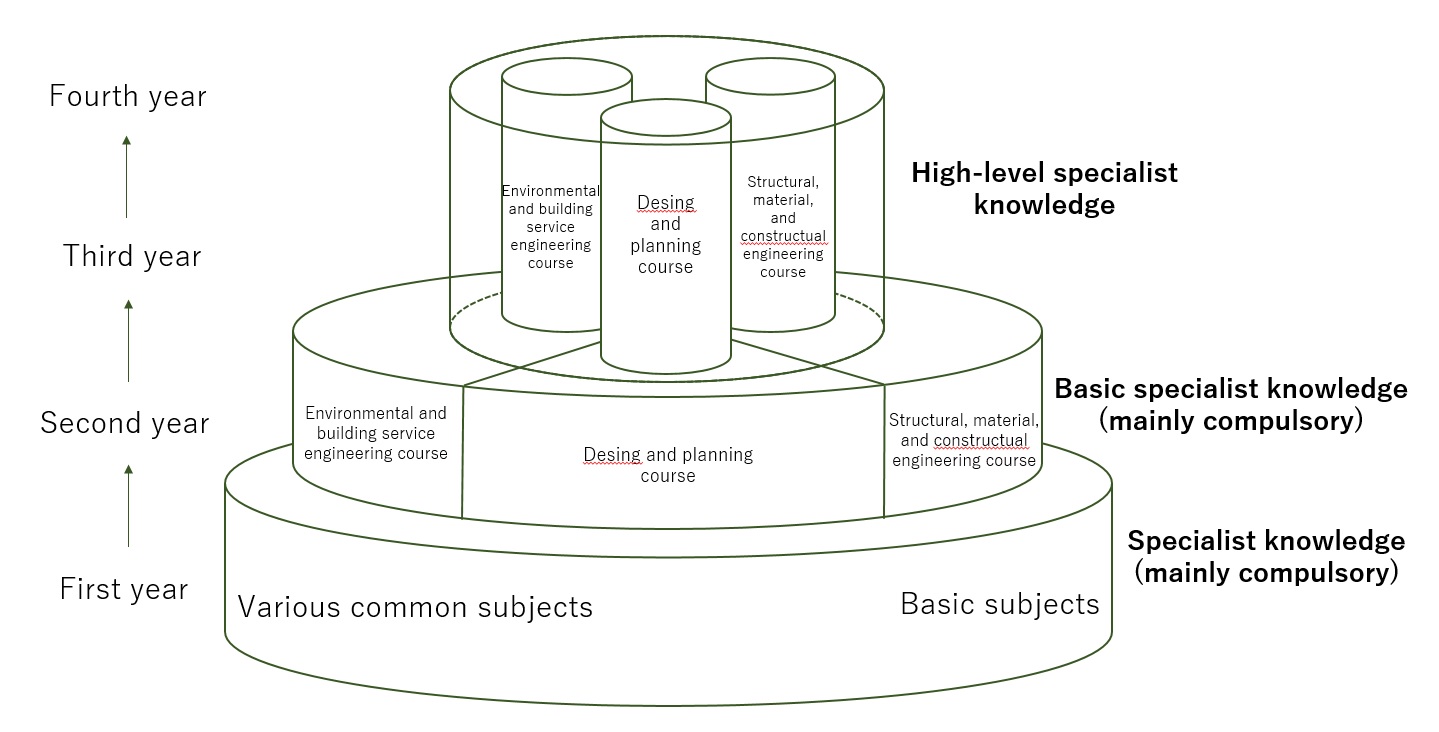The flow of architectural studies in the School of Engineering and the Graduate School of Environmental Studies
To study architecture at Nagoya University as an undergraduate, students must enroll in the School of Engineering’s Civil Engineering and Architecture Departments and, based on their record on classes at the end of the first year, they will then gain entrance to the architecture program. Postgraduate architecture students take the architecture course that is offered by the Graduate School of Environmental Studies’ Department of Environmental Engineering and Architecture. The students can choose to study for an engineering, environmental studies, or architecture degree in both master’ and dotoral courses.
The undergraduate education program
The program is certified as an educational qualification (university degree) to take an exam for the first-class architect. We apply the PDCA Cycle to improve the quality of education and ensure continuous improvement, providing education that aligns with the needs of the times.
The learning and educational objectives of the Civil Engineering and Architecture Departments’ architecture program
The study of architecture is the integrated study of the creation of spaces for the various activities in which human beings engage. The areas that are studied in the architecture program are broadening from mere architecture to encompass the urban environment and environments in general and expanding from the physical environment to the information environment as well. The academic, technical, and artistic skills that are needed by architects and by those who plan, design, build, and preserve our cities are taught in an integrated way based on the three areas of planning and design, environmental and building service engineering, and structural, material, and constructual engineering An inverted T-shaped curriculum is used to give concrete realization to these aims. Within this curriculum, all students first acquire basic knowledge in the three aforementioned fields, which allows them to grasp the perspective as it relates to architecture. Thereafter, students are able to select classes according to their own interests and independent judgment from among a range of specialist fields, thus acquiring in-depth, specialized knowledge. The curriculum aims to allow students to acquire essential, high-level, specialist knowledge on a secure, wide-ranging foundation of basic knowledge. The program also includes various types of practice (exercize) including face-to-face educations in the design and planning practice, and the graduation thesis research. Such activities are intended to foster in students a sense of social duty and a willingness to cooperate, so that they will apply the knowledge they have acquired in the service of society.
Summary of the T-shaped curriculum

Knowledge and concrete abilities that are imparted and fostered through studying specialist subjects in the architecture program
(B)The ability to estimate and evaluate the impact of architectural activity on society and nature and make a judgment on the appropriateness of that activity
(C)Wide-ranging basic specialist knowledge related to architecture and urban, and relevant design and technical capabilities in the areas of:
(1)Design and p
(2)Environment and building service
(3)Structural, material, and constructual techniques
(D)The design and technical capabilities that allow full, independent-minded, creative use of high-level specialist knowledge related to architecture and urban
(E)The ability to continuously and comprehensively grasp and analyze the problems that are involved in architecture and urban while striving to improve the quality of both
(F)The ability to always mutually acknowledge different values, cooperate with others, and make decisions while engaging in a wide-ranging exchange of opinions
(G)The ability to communicate with others using words, diagrams, and the impressions that are experienced during contact with natural and social phenomena and forms
(H)The ability to interpret, produce, and explain architectural documents
Curriculum
Curriculum tree diagram
For students starting their studies in the 2020 academic year, this diagram summarizes inter-subject links over the four-year duration of the architecture program.
Syllabus
These are documents that provide the detailed content of each class. There will be slight variations depending on the initial academic year.
Education and learning outcomes (in Japanese)
- Academic year 2018 General design practical assignment 2 (Graduation design project)
- Academic year 2017 General design practical assignment 2 (Graduation design project)
- Academic year 2016 General design practical assignment 2 (Graduation design project)
- Academic year 2015 General design practical assignment 2 (Graduation design project)
- Academic year 2014 General design practical assignment 2 (Graduation design project)
- Academic year 2011 General design practical assignment 2 (Graduation design project)